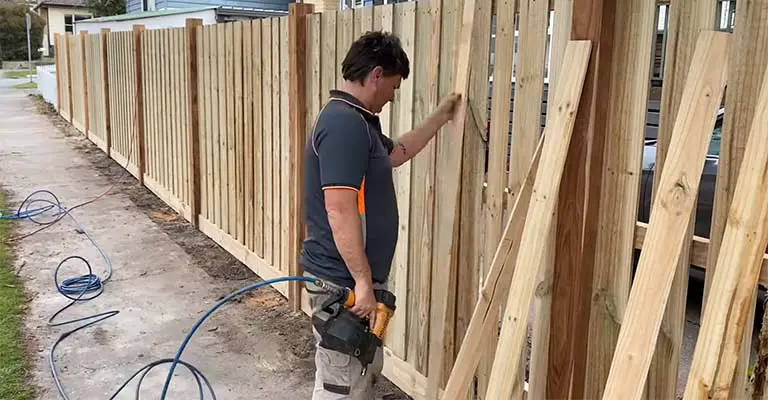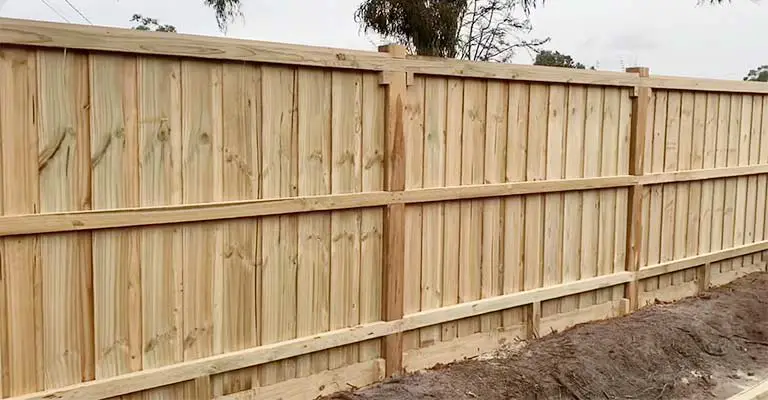Private fences are usually installed in the belief that they will create a privacy screen. Over time, however, larger gaps develop, and gaps are often left unfilled. Most of the time, this occurs as a result of the wood drying out and shrinking.
In this case, one might wonder why a gap is needed in the first place? Is it best to install fence boards as close together as possible without any gaps?
Due to the fact that the fence boards will shrink over time, it is usually not necessary to leave gaps between them.
If you leave too little space between fence boards, the boards will eventually warp, resulting in damage to the wood and an odd-looking fence.
As fence planks age, they tend to lose moisture content. Consequently, the planks may shrink, and a gap may appear.
In order to prevent this, fence boards should have a small gap between them, usually no greater than 1/4″.
It Is A Good Idea To Leave A Gap Between Fence Boards?
Even though you may prefer no gap at all, you might find that a small gap is a good idea for a number of reasons:
Expanding and contracting are possible.
Humidity and weather affect the condition of wood. Therefore, allowing a small gap is a good idea to allow for wood’s ability to shrink or expand at various times.
Wind can pass through it.
If the fence boards are spaced apart from each other, a small gap will allow wind to pass through, thereby reducing the amount of wind pressure on the fence.
Those who live in areas that experience high winds may need to take this into consideration.
As the gap grows over time, it becomes a bigger problem. This extra, unwanted space might require you to consider some approaches.
How Wide Should Fence Gaps Be?

You’re ready to install a brand-new fence, but you don’t know how big to make the gaps. When it comes to privacy fences, how wide is too wide?
Here’s a guide from your trusted experts at GoFullDIY.com to help you avoid wasting your time and energy guessing when you’ve already worked so hard.
The Standard Rule For Picket Fences
The picket style of fence is often seen with gaps between each board, whether it’s a traditional wood fence or a more modern vinyl fence.
Nevertheless, if you’ve never installed a fence before, you may not know how to determine the right gap size.
In terms of child safety and pet safety, you should aim for gaps no bigger than 4 inches, but there are many other factors to take into account.
Calculating Your Picket Amount
Taking measurements of the fence’s span and the location of your posts should be your first step before picking up a shovel or hammer.
You can then determine how many pickets you’ll need to fill in the space between your posts by writing down the length of the space between them.
Dividing the post spacing by the picket width and gap width will give you the picket width and gap width. Round up or down to the nearest whole number.
3.5 (picket width) + 2 (desired gap) = 5.5
96 (post space) / 5.5 = 17.45
17.45 = 17
How to Calculate Your Precise Gap Space
By multiplying the picket width by the number of pickets you can calculate the gap allowance by subtracting that number from the post spacing. Divide that number by the number of pickets plus one.
With this method, you’ll be able to determine the gap size most accurately. It’s always possible to get assistance from your local fence experts if math isn’t your forte!
17 (picket count) X 3.5 (picket width) = 59.5
96 (post space) – 59.5 = 36.5
36.5 / 18 (picket count plus one) = 2.02”
Gaps In Privacy Fences Are Not Uncommon
If you’re planning to install a privacy fence, you may believe that you don’t need to worry about gap sizes since the planks will simply be placed side-by-side without any space between them.
Placement of the planks so close together without enough breathing space, however, is a big problem. Whenever wood or vinyl fences are exposed to moisture or intense heat, they are prone to expanding and contracting.
Unless a gap is provided to compensate for these changes, the planks are forced into each other and can warp, crack, or break.
Therefore, even for privacy fences where you don’t wish to have anyone peering through, it is advised to leave a gap of approximately three quarters of an inch. It’s still impossible to get a clear view from outside with gaps this small.
What Can You Do to Fix a Gap Between Fence Boards?
Plank fences can be repaired with a plank fence by removing the planks and repositioning them if they have too large gaps. This approach was used by my neighbors purposefully.
After installing their wood plank privacy fence in Spring, they let it sit for the summer without any gaps. Due to the shrinkage of the wood, gaps had appeared at the end of summer.
As autumn approached, they removed every board from their fence and butted them back together. Because of this, the fence has less spacing between the boards than it would normally have.
The gaps haven’t gotten any wider after a couple of years. As a result of staining and sealing the fence, the gaps are very small, and the fence provides a nice level of privacy.
Unfortunately, I didn’t follow my neighbor’s example and have larger gaps than he does.
The fencing company I used at the time installed the boards almost without space on top of each other, but over time, the spacing between the boards has increased.
How Can I Cover Fence Gaps?

You can create more privacy in the gap areas of your fence if you are unable to reposition the planks.
Fence Screen
With screening, you can cover up the gaps easily without causing a lot of hassle. If you would like to install screening on the fence, you can simply purchase screening designed for this purpose.
It can also be used on wooden fences, even though they are typically designed for chain link fences. It won’t completely black out gaps, but it can certainly create a more private environment.
Shrubs and Trees
A shrub, tree, or other plant placed strategically in between fence boards might help cover up spacing between fence boards. A full fence cover won’t be necessary for every gap. These plants can be placed in areas that are most sensitive.
The most likely places for others to see through your fence are places where shrubs can be planted. Generally, these will be areas where people often stroll past neighboring buildings, streets, or walkways.
There is no perfect way to create a completely private backyard with this technique, but it can certainly shield your backyard from nosy neighbors and cover up the gaps in your fence where they are most visible.
Shadow Box Fence
You can also use shadowbox fencing to cover gaps in your fence. Planks are staggered on each side of this fence in order to create a staggered appearance. If you look at the fence straight on, there are no gaps.
While you can see through gaps looking straight on at a fence, looking at it from an angle will allow you to see through gaps as well.
As a former resident of houses with shadow box fences, I can tell you that while they work well for blocking straight-on observers, they are not very private when driving or walking.
Let It Be
Another option is to accept that wooden fences will have gaps from time to time. As soon as nature takes over, it is not possible to have a perfect fence made of wood.
If you want a fence, you can just decide that one with gaps is better than none at all. Vinyl fences tend to have no spacing between boards, so they may be the best choice if you need a fence without any spacing.
It is probably the case that you already possess a wooden fence since you are reading an article about gaps between fence boards.
The installation of a vinyl fence may not be an option, but if you need to replace your existing fence, you may want to consider it.
Wood Fence vs Vinyl Fence
A wood fence is the only one that has gaps. You should choose a vinyl fence if you want to avoid gaps altogether. If you choose vinyl from the start, you’ll save lots of time and frustration from dealing with gaps that are certain to occur.
Vinyl privacy fences have solid piece sections so there can be no gaps. It is the best choice if you are looking for complete privacy.
As well as being less maintenance-intensive, it will last a longer time. Parts and installation may be more expensive, but they are worth it in the long run. Unlike wood fences, you won’t need to seal your fence regularly.
It will take more maintenance to maintain a wood fence, and there is no way to completely eliminate gaps. If you want your yard to remain private, you’ll need to use other methods to cover the gaps.
Summary
New fence boards usually don’t need a gap between them since they will shrink over time and the gaps will naturally occur.
A small gap is all that is needed if you choose to leave one. Small amounts of spacing are more appropriate if you are installing seasoned planks that are dry and do not contain as much moisture.
The planks should be butted as close together as possible if I were to build another privacy fence. Over the years, I’ve watched the gap between my fence boards increase, so I’d like to ensure that it stays as small as possible.
There will always be gaps in a wooden fence, and the gaps will likely increase over time. You will have fewer gaps if you install the boards closer together.







